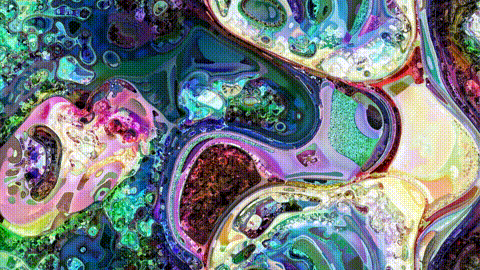Behind the Scenes with Jonathan McCabe
In our series Behind the Scenes, artists answer questions about their creative process, philosophy, and more. This installment features Jonathan McCabe. See some of his work here. (Read our other exclusive interviews with artists here.)
How do you know when a work is finished?
As a generative artist, I consider the work to be the program that generates the video file, rather than any particular instance of its output. The work is never finished, though it may languish for years before being taken up again. Some of my programs have parts that originated in the late 1980s. Some have become monstrous, with dead code and functions the compiler only lets through with warnings because they don’t follow the current language standard.
How would you describe your subject matter or the content of your work?
I am very interested in spontaneous pattern formation, in particular the idea from Alan Turing about how structure forms from his paper The Chemical Basis of Morphogenesis, where almost homogeneous fields collapse into patterns of stripes or spots, an example of spontaneous symmetry breaking.
Some of my work explores what is made possible by modeling and elaborating this process.
What are the 5 most important tools to your artistic practice?
*I definitely need a computer to run the program! I am using a workstation running Linux.
*A text editor to write the program with. I use Vi.
*A compiler to turn the human-readable text into machine language for the computer to execute. I use GCC.
*An image viewer to see the result. I use Display from Imagemagick
*Software to make a video file from a series of still images. I am using FFmpeg.
What do you feel when you look at your past work?
I feel a sense of panic that my old work is better than my new work, mixed with sadness that I spent so much time on it, and I’m still rehashing the same old stuff.
Which of your works means the most to you?
My Flowpi works mean the most to me at the moment. I like the almost organic look and the fluid motion. They are a combination of two kinds of simulation, a Turing pattern generator and a fluid flow model. It was a revelation to me that different systems could be usefully combined in this way.
How much of your work is accidental?
All and none. The programs themselves are explicit procedures that run on deterministic computers, so the output isn’t an accident. On the other hand, the initial conditions and the parameters are often determined by a pseudo-random number generator, so the work is completely accidental. On the third hand, the pseudo-random number generator is a deterministic program whose output is not accidental at all. On the fourth hand, I’m accidental myself, if there had never been DNA copying errors in my past I would be an amoeba, if I was anything at all.
In all honesty, what were the last 5 songs you listened to?
“One two, pick up your shoe, three four, knock at the door, five six, pick up stick…” by Author unknown
“Here come the Numtums, they’re furry and they’re fun…” by Author unknown
“Shimmer and Shine, whoo-oo-ooh, two of a kind, whoo-oo-ooh, from Salamai…” by Author unknown
“It’s Blaze, and the Monster Machines…” by Author unknown
“Paw Patrol, Paw Patrol, whenever you’re in trouble…” by Author unknown
If you could own the exclusive rights to any specific color, which would you choose (and why)? (i.e. Anish Kapoor owns Vantablack)
It would have to be a color that nobody would be wanting to use because it would pain me to think I was stopping anyone using a particular color. An obscure color, an unwanted color, but not too ugly as there is a use for horrible colors. Maybe beyond violet in the spectrum, as a color no-one can see probably won’t be missed. Up past ultra-violet, somewhere in the X-ray part of the spectrum. Or down the other end, there are regions in the terahertz range that are unused.
What do you think is the age at which people are at their most creative?
From my experience, the age at which people are their most creative would seem to be 4 years old, though I might revise that estimate in a year (I have a four-year-old). I am, however, encouraged by the example of people who have bloomed in later years, due to some kind of brain damage that has interfered with the parts of the brain that suppress creativity, for example, the temporal lobes.



